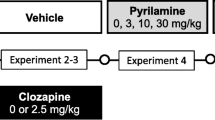Abstract
Two sets of experiments were carried out to compare the effects of fenfluramine and fluoxetine on consummatory and operant behaviour. In food-deprived rats allowed access to a 35% sucrose solution, an initial period of sucrose consumption was followed by a short period of grooming and exploratory behaviour, later superceded by resting. This “behavioural satiety sequence” was advanced by fluoxetine, but disrupted bydl-fenfluramine, which suppressed post-prandial resting, even at sub-anorectic doses. Fluoxetine also elicited resting behaviour following water drinking. However, this did not appear to be a non-specific sedative effect, since fluoxetine increased post-prandial grooming. In rats performing on random interval schedules of food reinforcement, fluoxetine caused proportionally greater decreases in responding on a reinforcement-lean schedule (RI-300s), as compared to a reinforcement-rich schedule (RI-7.5s); this effect is similar to that of a reduction in level of food deprivation. By contrast, fenfluramine reduced responding equally on both schedules. In both paradigms, the effects of fluoxetine were compatible with an increase in postprandial satiety, but the effects of fenfluramine were not.
Similar content being viewed by others
References
Antin J, Gibbs J, Young RC, Smith GP (1975) Cholecystokinin elicits the complete behavioural sequence of satiety in rats. Physiol Psychol 89:784–790
Booth DA, Gibson EL, Baker BJ (1986) Gastromotor mechanism of fenfluramine anorexia. Appetite [Suppl] 7:57–69
Blundell JE, (1986) Serotonin manipulations and the structure of feeding behaviour. Appetite [Suppl] 7:39–56
Blundell JE, Hill AJ (1987) Nutrition, serotonin and appetite: case study in the evolution of a scientific idea. Appetite 8:183–194
Blundell JE, Latham CJ (1980) Behavioural pharmacology of feeding. In: Silverstone T (ed) Drugs and appetite. Academic Press, London, pp 41–80
Blundell JE, McArthur RA (1978) Behavioural flux and feeding: continuous monitoring of food intake and food selection, and the video recording of appetitive and satiety sequences for the analysis of drug action. In: Garattini S, Samanin R (eds) Anorectic agents: mechanism of action and tolerance. Raven Press, New York, pp 19–43
Clifton PG, Barnfield AMC, Philcox L (1989) A behavioural profile of fluoxetine-induced anorexia. Psychopharmacology 97:89–95
Davison M, McCarthy D (1988) The matching law: a research review. Lawrence Erlbaum, Hillsdale, New Yersey
Fuller RW, Wong DT (1977) Inhibition of serotonin uptake. Fed Proc 36:2154–2158
Garattini S, Mennini T, Bendotti C, Invernizzi R, Samanin R (1986) Neurochemical mechanism of action of drugs which modify feeding via the serotonergic system. Appetite [Suppl] 7:15–38
Goudie AJ, Thornton EW, Wheeler TJ (1976) Effect of Lilly 110140, a specific inhibitor of 5-hydroxytryptamine uptake on food intake and on 5-hydroxytryptophan-induced anorexia. J Pharm Pharmacol 28:318–320
Heyman GM, Monaghan MM (1987) Interpretations of the matching law: new data, methodological issues and literature. J Exp Psychol [Anim Behav Proc] 13:384–394
Kushner LR, Mook DG (1984) Behavioural correlates of oral and post-ingestive satiety in the rat. Physiol Behav 33:713–718
Montgomery AMJ, Willner P (1988) Fenfluramine disrupts the behavioural satiety sequence in rats. Psychopharmacology 94:397–401
Morley MJ, Bradshaw CM, Szabadi E (1984) The effects of pimozide on variable interval performance: a test of the anhedonia hypothesis of the mode of action of neuroleptics. Psychopharmacology 84:531–536
Morley MJ, Bradshaw CM, Szabadi E (1985) The effect ofd-amphetamine on operant behaviour maintained under variableinterval schedules of reinforcement. Psychopharmacology 87:207–211
Pinder RM, Brogden RN, Gawyer RR, Speight TM, Avery GS (1975) Fenfluramine: a review of its pharmacological properties and its therapeutic efficacy in obesity. Drugs 10:241–323
Ruddle HV, Morley MJ, Bradshaw CM, Szabadi E (1984) The effect of pentobarbitone on variable interval performance: analysis in terms of Herrnstein's equation. Psychopharmacology 84:520–525
Smith GP, Gibbs J (1975) Postprandial satiety. In: Sprague JM, Epstein AN (eds) Progress in psychobiology and physiological psychology, vol. 8. Academic Press, New York, pp 180–242
Willner P, Towell A, Muscat R (1987) Effects of amphetamine and pimozide on reinforcement and motor parameters in variableinterval performance. J Psychopharmacol 1:140–153
Willner P, Sampson D, Phillips G, Muscat R (1989) A matching law analysis of the effects of dopamine receptor antagonists. Psychoipharmacology 101:560–567
Author information
Authors and Affiliations
Rights and permissions
About this article
Cite this article
Willner, P., McGuirk, J., Phillips, G. et al. Behavioural analysis of the anorectic effects of fluoxetine and fenfluramine. Psychopharmacology 102, 273–277 (1990). https://doi.org/10.1007/BF02245933
Received:
Revised:
Issue Date:
DOI: https://doi.org/10.1007/BF02245933




